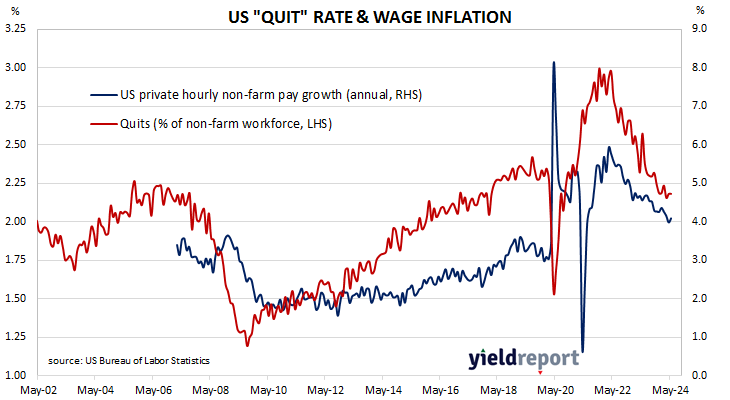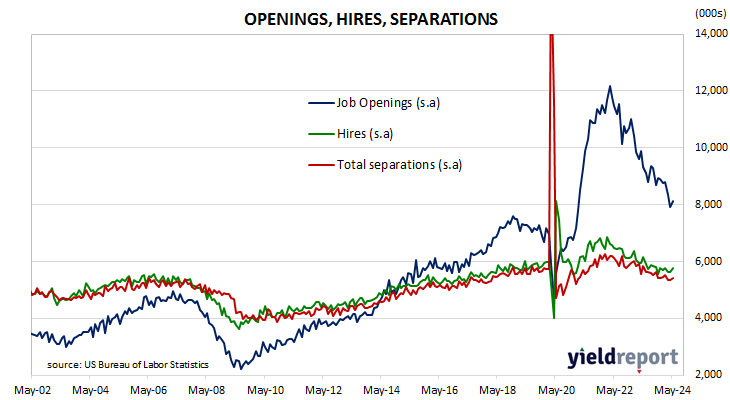Summary: US quit rate steady at 2.2% in May; Westpac: provides further evidence of labour demand, supply coming into balance; US Treasury yields decline; expectations of Fed rate cuts soften; Westpac: job opening rate little changed from May, within 0.5% of pre-pandemic level; more quits, openings, separations.
The number of US employees who quit their jobs as a percentage of total employment increased slowly but steadily after the GFC. It peaked in March 2019 and then tracked sideways until virus containment measures were introduced in March 2020. The quit rate then plummeted as alternative employment opportunities rapidly dried up. Following the easing of US pandemic restrictions, it proceeded to recover back to its pre-pandemic rate in the third quarter of 2020 and trended higher through 2021 before easing through 2022 and 2023.
Figures released as part of the latest Job Openings and Labor Turnover Survey (JOLTS) report show the quit rate remained steady in May. 2.2% of the non-farm workforce left their jobs voluntarily, unchanged from April. Quits in the month increased by 7,000 while an additional 272,000 people were employed in non-farm sectors.
“The May JOLTS survey provided further evidence of labour demand and supply coming into balance,” said Westpac senior economist Pat Bustamante.
US Treasury yields declined modestly across the curve on the day. By the close of business, 2-year, 10-year and 30-year Treasury bond yields had each lost 2bps to 4.74%, 4.44% and 4.61% respectively.
In terms of US Fed policy, expectations of a lower federal funds rate in the next 12 months softened slightly, albeit with close to four 25bp cuts currently factored in. At the close of business, contracts implied the effective federal funds rate would average 5.31% in August, 2bps less than the current spot rate, 5.245% in September and 5.075% in November. June 2025 contracts implied 4.405%, 93bps less than the current rate.
The rise in total quits was led by 32,000 more resignations in the “Professional and business services” sector while the “Accommodation and food services” sector experienced the largest decrease, falling by 61,000. Overall, the total number of quits for the month increased from April’s revised figure of 3.542 million to 3.549 million.
Total vacancies at the end of May increased by 221,000, or 2.8%, from April’s revised figure of 7.919 million to 8.140 million. The rise was driven by 142,000 more open positions in the “State and local government” sector while the “Accommodation and food services” sector experienced the single largest decrease, falling by 147,000. Overall, 11 out of 18 sectors experienced more job openings than in the previous month.
“The job opening count was a touch higher than the market expected at 8.14 million, but the job opening rate was little changed from May and within 0.5% of the pre-pandemic level,” Bustamante added.
Total separations increased by 85,000, or 1.6%, from May’s revised figure of 5.337 million to 5.422 million. The rise was led by the “Professional and business services” sector where there were 110,000 more separations while the “Accommodation and food services sector experienced 48,000 fewer separations. Separations increased in 10 of the 18 sectors
The “quit” rate time series produced by the JOLTS report is a leading indicator of US hourly pay. As wages account for around 55% of a product’s or service’s price in the US, wage inflation and overall inflation rates tend to be closely related. Former Federal Reserve chief and current Treasury Secretary Janet Yellen was known to pay close attention to it.



